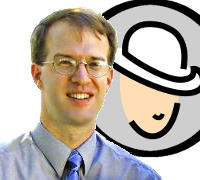Elephants, Riders, and Sales, Oh My!
by Antone Roundy | Add Your Comments | Marketing, Product Reviews
When you pitch a product, you're asking the customer to change: from apathetic to interested, from ignorant to informed, from resistant to accepting, from passive to active, from satisfied to evangelizing.
Most people don't like change. Even people who want to change resist it. (In fact, people who want change the most are probably the most resistant -- otherwise, they'd have changed already, right?)
Why is change so hard, and how can you hope to succeed?
A few months ago, I listened to a book on CD that made the analogy of an elephant and a rider. The rider directs the elephant, and as long as the elephant accepts direction, everything goes well. The powerful elephant does most of the work, and everybody's happy.
But if the elephant decides it doesn't like the way things are going, the rider doesn't stand a chance -- he may tug on the reigns and get his way for little while, but in the end, the elephant is simply too powerful.
Change is hard unless the elephant goes along with it.
What is the elephant, and who is the rider? The elephant is the "old brain" I was talking about yesterday -- the subconscious. The rider is the conscious mind.
In their book Switch: How to Change Things When Change Is Hard, Chip and Dan Heath talk about how to figure out why the elephant is unhappy, and how to make it happy with the changes your trying to make.
What's Wrong With The Elephant?
They discuss 3 misunderstandings that often steer us in the wrong direction as we're trying to implement change:
1. What looks like resistance is often lack of clarity.
If customers aren't doing what you want, maybe it's because you're not telling them what you want them to do.
Copywriting pros often talk about how important it is to include a clear "call to action" in your sales materials. For example, how many sales have been lost because a customer couldn't find the order button. The simple addition of "click here to order" can make all the difference in the world.
How many blog posts never get comments because the blogger never asks for them? How many people never tell anyone about a great product they just bought because the seller doesn't suggest that they tell their friends -- or because they don't say how: "forward this email to someone who might need this information", "click here to (tweet/share this on Facebook/etc.)"
2. What looks like laziness is often exhaustion.
You may have the rider sold on your product (buying, using it consistently, evangelizing it, etc.) So why don't they? Because the elephant refuses to budge. Until you've got the elephant interested, they're not going anywhere.
My post from yesterday covers a lot of ways to get the elephant interested and moving.
3. What looks like a people problem is often a situation problem.
The book discussed a study that found that people eat more popcorn if they're given a bigger bucket. Seems obvious -- you can only eat as much as you're given, right? But the popcorn in the study was nasty-tasting, stale stuff you wouldn't feed your neighbors yappy dog (my neighbor has a very yappy dog, and my mother-in-law may be the nicest person in her family, so I'll go with the dog here -- no offense to dog-lovers!) People still ate some of it -- and the bigger the bucket, the more they ate.
Dieting experts understand this concept, which is why they recommend using small plates. It's not the people that are the problem -- if you give someone a large plate, they're going to eat more, no matter how much you tell them about calorie counts, or how much self control they have.
This is only one example of how you need to "shape the path" (as the book says) to make it easier for people to go the direction you want them to go. Make it easy. Make it socially acceptable. Be supportive.
More Ways of Motivating the Elephant
A few more tips the book covers (in depth -- I'm giving it a pretty light treatment here) include:
- focusing on success to help the elephant believe it can succeed. Show examples of underdogs who've made good with your product -- people who customers can look at and say "if that person can do it, I can definitely do it." It occurs to me that examples of small successes may be more powerful than examples of large successes. Why? Because they're more believable, and are easier for most people to relate to themselves.
- rewarding the elephant along the way. Get customers to take small steps that give them positive feedback (eg. give an unadvertised bonus if they join your mailing list, respond to their comments on your blog, etc.). Then they'll be more interested in continuing through your sales process.
- helping people develop an identity consistent with what you want them to do. Start off with small requests that are easily accepted and help them see themselves as "the kind of person who [does the kind of thing you want them to do]." The book talks about an interesting study about how getting a small commitment that influences identity can lead to much bigger commitments that pretty much require that identity to be in place in advance.
- If customers are likely to experience failures along the way, make sure they know in advance to expect failures on the path to success. I'd guess that the best way to do this is to tell stories of people who tried whatever you want them to do several times, learned from their failures, and then achieved successes that made it all worth it.
As you've probably gathered by now, Switch isn't a marketing text. Yet the things it teaches apply directly to marketing. The great thing about this book is that you can apply the same concepts to other changes you'd like to make: in your personal life, in your family, in your community, etc. It's like two books for the price (and reading time) of one. I strongly recommend picking up a copy and reading it for yourself.
Well, that wraps up my week of book reviews. I've read a few other books recently, but those are the one's I recommend the most highly.
Have you read any good marketing books lately?





